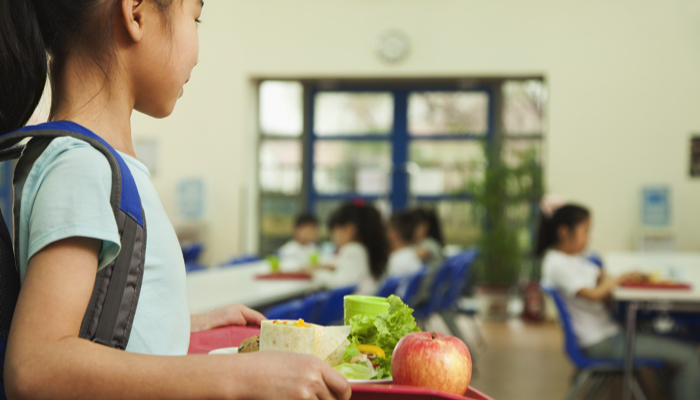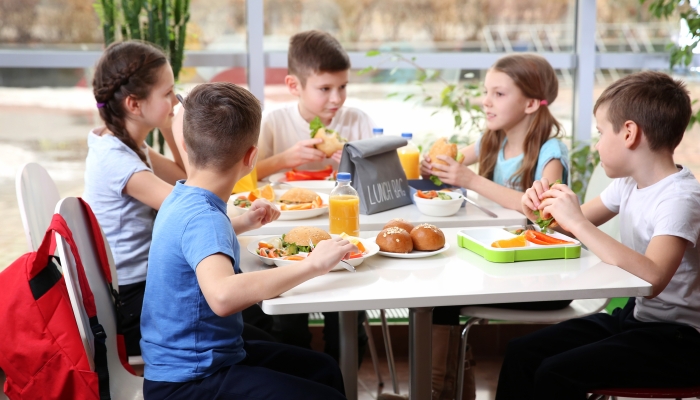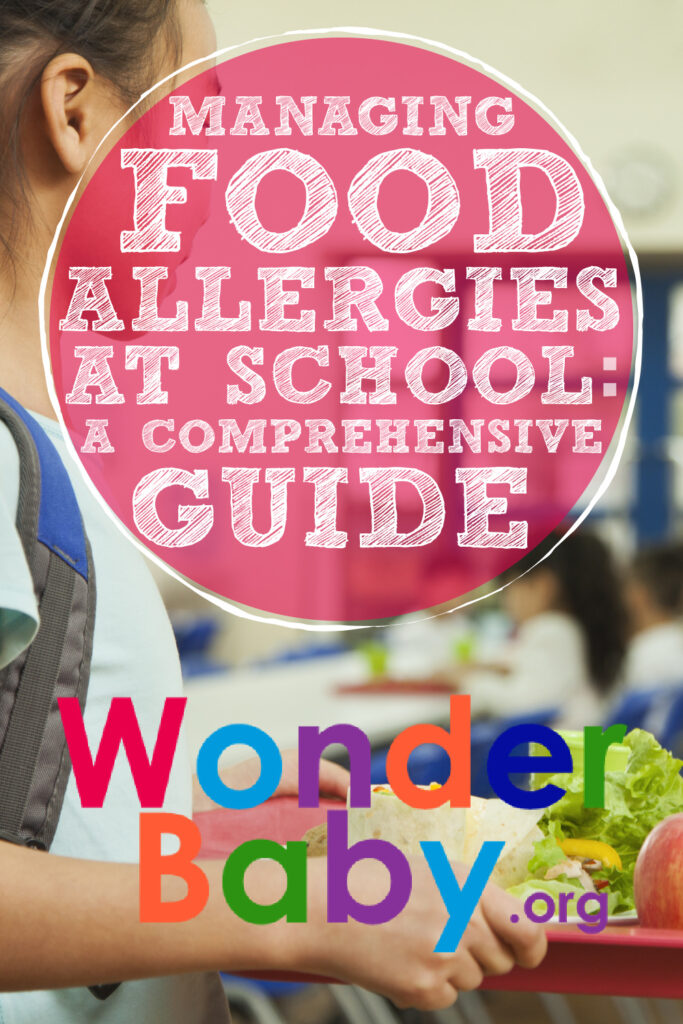Managing Food Allergies at School: A Comprehensive Guide

- Talk with school staff involved in your child’s care about strictly avoiding certain foods.
- Your child’s teacher or school nurse can educate children and families to help prevent food allergy emergencies in the classroom.
- Recognize the signs of an anaphylactic reaction and know how to respond.
- Food allergies at school can be managed successfully!
Fall is rapidly approaching and many kids are counting down the days until school starts. Some look forward to returning to a routine and seeing friends, while others wish summer would last forever.
Understandably, you may be nervous about sending your child off to school, whether that educational time happens for full days, half days, or some blend of the two. These normal worries may be especially heightened if you’re the parent of a child with food allergies.
It can be a source of real tension and anxiety as you and your child work through how to manage food allergies at school. You might wonder: How are school staff members trained to respond to a child experiencing a severe allergic reaction? Can your child carry their emergency medication or epinephrine auto-injector with them, or is it kept safe somewhere else in the building? What about special treats for classroom celebrations?
If facing the maze of food allergy management in a school setting leaves you scratching your head, read on! We’ve gathered some ideas to help make this school year the best one yet for you and your student.
Creating a Safe School Environment for Kids With Allergies

Food allergy research, such as the 2011 study “The prevalence, severity, and distribution of childhood food allergy in the United States,” published in Pediatrics11. Gupta, R. S., Springston, E. E., Warrier, M. R., Smith, B., Kumar, R., Pongracic, J., & Holl, J. L.. The Prevalence, Severity, and Distribution of Childhood Food Allergy in the United States. Pediatrics. 2011;128(1), e9–e17. https://doi.org/10.1542/peds.2011-0204 by Gupta et al., reports that “an electronic household survey in the USA estimated that 8% of children have a food allergy, with 2.4% having multiple food allergies and 3% having experienced severe reactions.”
Chances are, your child’s school and school district have had previous encounters with students with food allergies and have policies and training mechanisms in place to handle food allergies and protect students.
When your child is about to enter a new school, schedule a meeting with the principal of your child’s school to learn how they provide a safe educational environment, including the management of food allergies, for affected students.
During that meeting, you might discuss the following topics:
Disability Accommodations
If your child attends public school, the district and individual school community will probably be aware of the Individuals with Disabilities Education Act22. About IDEA. Individuals with Disabilities Education Act. https://sites.ed.gov/idea/about-idea (IDEA) that entitles children to “a free and appropriate public education [that] is available to all eligible children with disabilities.” Food allergies are generally considered a disability.
Further, children with food allergies are included in federal and state laws, such as Section 504 of the Rehabilitation Act of 1973. Section 50433. Food Allergy Guidelines for Michigan Schools. Michigan Department of Education. https://www.michigan.gov/-/media/Project/Websites/mde/Year/2016/06/27/Food_Allergy_Guidelines_for_Michigan_Schools.pdf?rev=75d86a56b5f6424284089261cd30c965 “prohibits discrimination against qualified persons with disability in programs or activities that receive federal financial assistance. Students with a life-threatening food allergy are generally considered eligible for protection under Section 504.”
Private schools may not have the same responsibilities under IDEA or other federal and state laws as their public school counterparts: Contact your child’s principal or district superintendent for clarification well in advance of the school year.
Training for School Staff
The district’s role is to regularly provide professional development to their teachers and staff. At times, this education will also involve the management of food allergies in the school setting.
A school nurse or other qualified individual may provide inservices, reviewing such topics as:
- Decoding food labels
- Explaining cross-contact (also known as cross-contamination) and reviewing ways in which it occurs
- Clearly identifying at-risk students who experience severe allergic reactions
- Identifying and managing food allergy emergencies
- Reviewing and demonstrating the use of an epinephrine auto-injector
- Developing and reviewing safe practices in the school cafeteria, including seating arrangements
A standardized approach among all school staff who interact with your child is key to successful food allergy management at school and avoiding a food allergy emergency.
Creating an Allergen-Free Environment
In a busy setting like school, it may seem unrealistic to talk about spaces that are allergen-free environments. However, alternate seating arrangements for meals may be necessary as a means to protect children from accidental exposure.
In your discussion with your child’s principal, be prepared to talk about your child’s symptoms when exposed to their specific allergens. Depending on their method of exposure (contact44. Tan, B. M., Sher, M. R., Good, R. A., & Bahna, S. L.. Severe food allergies by skin contact. Annals of Allergy, Asthma & Immunology. 2001;86(5), 583–586. https://doi.org/10.1016/s1081-1206(10)62908-0, ingestion55. Abrams, E. M., & Sicherer, S. H.. Diagnosis and management of food allergy. Canadian Medical Association Journal. 2016;188(15), 1087–1093. https://doi.org/10.1503/cmaj.160124, or airborne66. Ramirez, D. A., & Bahna, S. L.. Food hypersensitivity by inhalation. Clinical and Molecular Allergy. 2009;7(4). https://doi.org/10.1186/1476-7961-7-4), “safe zones” may be used as a means of protecting students as part of a successful food allergy management strategy.
School Nutrition Professionals
If your child will be receiving a hot breakfast or lunch as a part of their school day, a discussion with the food service staff may also be very valuable. These individuals can answer detailed questions about menu items and training of cafeteria staff—or even provide food labels to ensure the safety of certain foods.
Forms
Many school districts require documentation from your child’s doctor outlining the nature of your child’s allergies and the appropriate response in the event of accidental exposure.
Other documents are also necessary to allow school staff or your child’s teacher to administer life-saving medication in the event of a severe allergic reaction.
Contact the school secretary, receptionist, or school nurse to obtain these school forms before the beginning of the new school year.
Managing Food Allergies in the Classroom

Most teachers recognize that families managing food allergies approach school with a heightened sense of worry or anxiety surrounding their child’s safety and are very open to conversations in learning how to best include and protect children with a food allergy.
In my experience as the mother of a child with severe food allergies, I’ve learned there’s a wide variety of familiarity in managing life-threatening allergies among teachers: Some have had previous students with food allergies, while others are new to the process of managing food allergies or the potential of allergic reactions at school.
In the month or so before the school year begins, I make contact with my child’s teacher for that year, and we discuss the following:
Guidelines for Safety
Your child’s teacher will be your main contact in terms of daily management of your child’s allergy throughout the year. In light of this fact, it makes sense that the teacher has access to as much information as they need to protect your child while at school, including additional staff training.
At a minimum, my conversation with the teacher includes the following:
- A review of my child’s allergens and whether the allergy is contact, ingestion, or airborne. Depending on the method of exposure, alternate seating arrangements may need to occur in the classroom during snacks or meals.
- My child’s symptoms of an allergic reaction, including anaphylactic reactions. Early care is critical to successfully managing accidental exposure.
- A review of what care is required if my child experiences a food allergy emergency. Your pediatric allergy staff can also outline this process in the documentation they send to the school for the administration of life-saving medication.
- A request to communicate with families regarding my child’s food allergy. Many teachers send a welcome newsletter in the weeks before school with information about their classroom for that year. It’s very appropriate to ask the teacher to include a paragraph saying something like, “As a reminder, we are a peanut-free classroom” or “We have a student with a severe dairy allergy this year—please contact the teacher before bringing in treats.”
- How we will manage school snacks, holidays, and birthday celebrations. Every year, I’m reminded anew of the number of events that involve food. Ask the teacher to outline how they like to celebrate certain holidays (a particularly big issue in elementary school, where food treats and food-centered activities abound). At a minimum, consider having a box of safe snacks available for your child during these times.
- How we will manage field trips. If possible, find out well ahead of time where the field trips are and if food will be served while there (such as a doughnut from the site while on a trip to the pumpkin patch). Contacting the facility to determine the safety of such foods before arrival makes it much easier for everyone on the actual day. School policy usually dictates that the teacher carry emergency medications for all affected students, such as rescue inhalers for asthmatics and medications to treat allergic reactions for children with insect or food allergies.
- My child’s ability to self-manage. Individual children range widely in this ability. The ability to self-manage includes things like being able to read, knowing how to decode a food label, and having the ability to politely decline a yummy-looking treat if its safety is debatable or unknown. Most children need a lot of help in this area, especially if their food allergy has been recently diagnosed.
- Resources for the teacher. If at all possible, try to provide your teacher with a list of safe snacks for your child and bring it with you to the meeting. In my experience, teachers love having a handy reference of safe foods and can often make adjustments to food-based craft and science experiments if they have options. This information can be as formal as my favorite candy guide from Kids with Food Allergies77. KFA Food Bloggers. Allergy-Friendly Candy Guide. Kids With Food Allergies Foundation. 2017. https://community.kidswithfoodallergies.org/blog/allergy-friendly-easter-candy-guide (includes custom searches based on specific allergens, like tree nuts!) or a simple list created by you.
It’s important to remember that you, the teacher, the school nurse, and the rest of the school staff are all members of your child’s team working towards the same goal: A safe, enjoyable school year where your child’s social and academic needs are being met.
Emergency Preparedness for Kids With Food Allergies

For children living with food allergies, the possibility of severe reactions is a very real concern.
Experts, such as those at Food Allergy Research and Education (FARE88. What Is a Food Allergy? Food Allergy Research & Education. https://www.foodallergy.org/resources/what-food-allergy), remind us that “food allergy may occur in response to any food, and some people are allergic to more than one food. Food allergies may start in childhood or as an adult. All food allergies have one thing in common: They are potentially life-threatening.”
Recognizing Anaphylaxis
Anaphylaxis99. Anaphylaxis: Causes, Symptoms & Treatment. American College of Allergy, Asthma & Immunology. 2018. https://acaai.org/allergies/symptoms/anaphylaxis is the medical term for a severe reaction (caused by the overproduction of chemicals) that puts an individual into shock. Allergies to foods (such as peanuts or tree nuts), insect stings, medications, and latex tend to be common offenders.
Children experiencing a food allergy emergency may exhibit symptoms like:
- Trouble breathing
- Hives or swelling
- Tightness of the throat
- Hoarse voice
- Nausea
- Vomiting
- Abdominal pain
- Diarrhea
- Dizziness
- Fainting
- Low blood pressure
- Feeling of doom
- Cardiac arrest
If you suspect a child in your care is experiencing a severe allergic reaction, get help promptly and administer emergency medications: Time does not improve anaphylaxis and early care is critical!
Responding to Emergencies
Emergency physicians and experts at the American College of Allergy, Asthma, and Immunology developed the Be S.A.F.E. action guide to direct steps when responding to a life-threatening allergic reaction.
The most important notes in this guide for a school team are:
- S: Seek immediate medical help. This includes calling 911 to transport the child to the nearest emergency facility at the first sign of anaphylaxis—even if you’ve already given the epinephrine auto-injector.
- A: Identify the allergen. This information will be vital for the student’s family to determine if this event indicates a new allergy or potential cross-contact. The best way to prevent anaphylaxis is to avoid its trigger.
- F: Follow up with your doctor. Be sure to follow up with your physician and see a specialist, especially if you suspect this may be a new allergen.
- E: Carry epinephrine for emergencies. In my experience, sometimes people are odd about being asked to give epinephrine to treat a food allergy emergency. Sometimes they worry they’ll do it wrong, or that “maybe it’s not actually needed or not bad enough—I don’t want to make a bad thing worse.”
Students with food allergies depend on their family members and school team to help them recognize the signs of anaphylaxis and give life-saving medications.
Education programs, articles, and videos1010. How to Use an Epinephrine Auto-Injector. Food Allergy Research & Education. https://www.foodallergy.org/resources/how-use-epinephrine-auto-injector are available if you or another individual on your child’s team have questions about the necessity and administration of epinephrine.
Supporting the Emotional Well-being of Children with Food Allergies

Children with chronic, life-threatening illnesses are at increased risk of anxiety, and children with severe food allergies are no different.
In 2011, Pao and Bosk described “chronic medical illness is a significant risk factor for the development of an anxiety disorder and the prevalence rate of anxiety disorders among youths with chronic medical illnesses is higher compared to their healthy counterparts” in their study “Anxiety in medically ill children/adolescents” published in Depression and Anxiety1111. Pao, M., & Bosk, A.. Anxiety in medically ill children/adolescents. Depression and Anxiety. 2010;28(1), 40–49. https://doi.org/10.1002/da.20727.
Similarly, Elghoudi and Narchi published a study in 2022 called “Food allergy in children- the current status and the way forward” in the World Journal of Clinical Pediatrics1212. Elghoudi, A., & Narchi, H.. Food allergy in children—the current status and the way forward. World Journal of Clinical Pediatrics. 2022;11(3), 253–269. https://doi.org/10.5409/wjcp.v11.i3.253 that reports “the condition [food allergies] may cause stress, fear, [and] anxiety in affected children and their parents alike.”
When working with children with a food allergy, it’s important to remember that they are children first: Said differently, they have the same needs for inclusion, belonging, and acceptance as their peers.
Fostering Inclusion
Inclusion and awareness of individuals—especially children—with disabilities of all forms is currently a major focus in education. Children with a variety of health, physical, emotional, learning, and behavioral needs are becoming an accepted part of mainstream classrooms, with written legislature protecting their presence: There’s never been a better time to be different.
Check out the following suggestions for kids and parents to foster the inclusion of children with any sort of disability or food allergy.
| Children | Both | Parents |
| Encourage appropriate self-advocacy | Use people-first language; (ex. “Person with a disability” instead of “disabled person”. | Present yourself as a resource; welcome questions from teachers and parents about food allergies |
| Balance curiosity with respect | Role model inclusiveness | Encourage friendships with understanding children and families |
| Identify similarities and differences (ex. “Mimi isn’t able to eat peanuts because they make her very sick, but she likes to play on the swings, just like you.) | Bring non-food treats to school for prizes or rewards |
Addressing Negative Behaviors
As parents, we may remember our days of being bullied or teased and are concerned about the same for our children—particularly if they have a disability.
In 2017, Fong and colleagues published a study called “Bullying and quality of life in children and adolescents with food allergy” in the Journal of Paediatrics and Child Health1313. Fong, A. T., Katelaris, C. H., & Wainstein, B.. Bullying and quality of life in children and adolescents with food allergy. Journal of Paediatrics and Child Health. 2017;53(7), 630–635. https://doi.org/10.1111/jpc.13570 that reports children with food allergies and allergic reactions are at increased risk of bullying from peers.
Bullying is never acceptable behavior. Talk with your child’s teacher and principal promptly if you suspect your child is being harassed.
Children with food allergies and severe allergic reactions can attend school safely when all members of the school staff working with your child are aware of their condition and consistently follow identified safety steps. By taking a proactive management approach, your child can experience food allergy success and hopefully avoid allergic reactions.
References
- Gupta, R. S., Springston, E. E., Warrier, M. R., Smith, B., Kumar, R., Pongracic, J., & Holl, J. L. (2011). The Prevalence, Severity, and Distribution of Childhood Food Allergy in the United States. Pediatrics, 128(1), e9–e17. https://doi.org/10.1542/peds.2011-0204
- About IDEA. Individuals with Disabilities Education Act. (n.d.). https://sites.ed.gov/idea/about-idea
- Food Allergy Guidelines for Michigan Schools. Michigan Department of Education. (n.d.). https://www.michigan.gov/-/media/Project/Websites/mde/Year/2016/06/27/Food_Allergy_Guidelines_for_Michigan_Schools.pdf?rev=75d86a56b5f6424284089261cd30c965
- Tan, B. M., Sher, M. R., Good, R. A., & Bahna, S. L. (2001). Severe food allergies by skin contact. Annals of Allergy, Asthma & Immunology, 86(5), 583–586. https://doi.org/10.1016/s1081-1206(10)62908-0
- Abrams, E. M., & Sicherer, S. H. (2016). Diagnosis and management of food allergy. Canadian Medical Association Journal, 188(15), 1087–1093. https://doi.org/10.1503/cmaj.160124
- Ramirez, D. A., & Bahna, S. L. (2009). Food hypersensitivity by inhalation. Clinical and Molecular Allergy, 7(4). https://doi.org/10.1186/1476-7961-7-4
- KFA Food Bloggers. (2017, March). Allergy-Friendly Candy Guide. Kids With Food Allergies Foundation. https://community.kidswithfoodallergies.org/blog/allergy-friendly-easter-candy-guide
- What Is a Food Allergy? Food Allergy Research & Education. (n.d.). https://www.foodallergy.org/resources/what-food-allergy
- Anaphylaxis: Causes, Symptoms & Treatment. American College of Allergy, Asthma & Immunology. (2018, January 29). https://acaai.org/allergies/symptoms/anaphylaxis
- How to Use an Epinephrine Auto-Injector. Food Allergy Research & Education. (n.d.). https://www.foodallergy.org/resources/how-use-epinephrine-auto-injector
- Pao, M., & Bosk, A. (2010). Anxiety in medically ill children/adolescents. Depression and Anxiety, 28(1), 40–49. https://doi.org/10.1002/da.20727
- Elghoudi, A., & Narchi, H. (2022). Food allergy in children—the current status and the way forward. World Journal of Clinical Pediatrics, 11(3), 253–269. https://doi.org/10.5409/wjcp.v11.i3.253
- Fong, A. T., Katelaris, C. H., & Wainstein, B. (2017). Bullying and quality of life in children and adolescents with food allergy. Journal of Paediatrics and Child Health, 53(7), 630–635. https://doi.org/10.1111/jpc.13570

The information WonderBaby provides is not intended to be, and does not constitute, medical or other health advice or diagnosis and should not be used as such. Always consult with a qualified medical professional about your specific circumstances.
Related Posts

Eye Conditions and Syndromes, Visual Impairment
Neuralink Announces Plans to Restore Sight to the Blind with Brain Chip
Elon Musk’s company Neuralink has announced plans to begin human trials of its new “Blindsight” brain chip by the end of 2025.

Special Needs
5 Spring Cleaning Tips for Families of Children with Disabilities
Spring cleaning is an opportunity to create a more accessible, organized, and supportive space for your child with disabilities. Declutter, deep clean, and refresh!

Visual Impairment
The Gift of Understanding: How a Young Child Helps His Blind Father Navigate Life
When a parent is blind, it’s natural for people to wonder how their sighted child will adapt. Will they struggle to understand their parent’s needs? Will they feel burdened by...